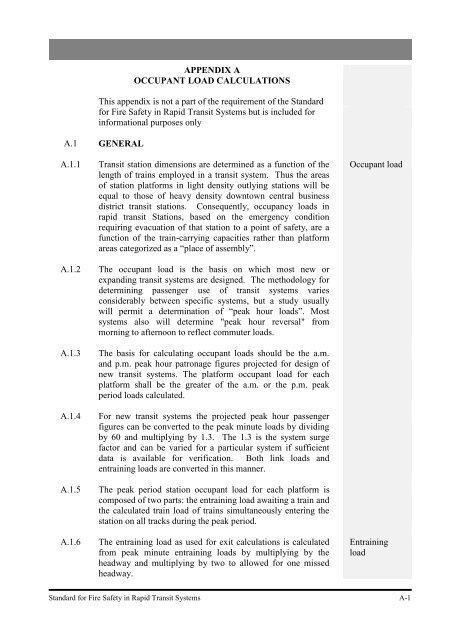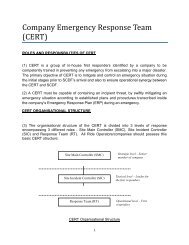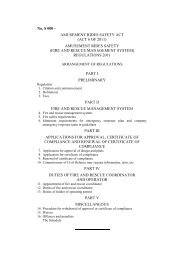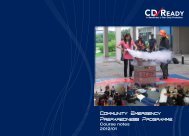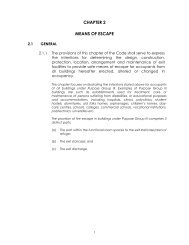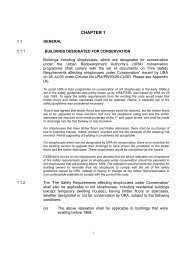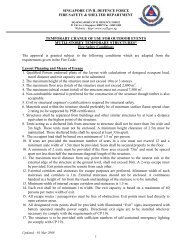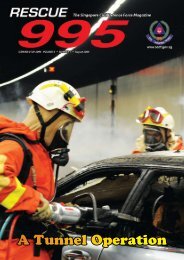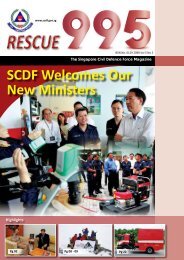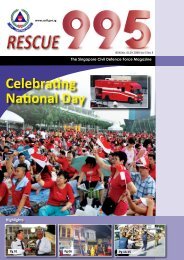Standard for Fire Safety in Rapid Transit Systems - Singapore Civil ...
Standard for Fire Safety in Rapid Transit Systems - Singapore Civil ...
Standard for Fire Safety in Rapid Transit Systems - Singapore Civil ...
You also want an ePaper? Increase the reach of your titles
YUMPU automatically turns print PDFs into web optimized ePapers that Google loves.
APPENDIX A<br />
OCCUPANT LOAD CALCULATIONS<br />
This appendix is not a part of the requirement of the <strong>Standard</strong><br />
<strong>for</strong> <strong>Fire</strong> <strong>Safety</strong> <strong>in</strong> <strong>Rapid</strong> <strong>Transit</strong> <strong>Systems</strong> but is <strong>in</strong>cluded <strong>for</strong><br />
<strong>in</strong><strong>for</strong>mational purposes only<br />
A.1 GENERAL<br />
A.1.1 <strong>Transit</strong> station dimensions are determ<strong>in</strong>ed as a function of the<br />
length of tra<strong>in</strong>s employed <strong>in</strong> a transit system. Thus the areas<br />
of station plat<strong>for</strong>ms <strong>in</strong> light density outly<strong>in</strong>g stations will be<br />
equal to those of heavy density downtown central bus<strong>in</strong>ess<br />
district transit stations. Consequently, occupancy loads <strong>in</strong><br />
rapid transit Stations, based on the emergency condition<br />
requir<strong>in</strong>g evacuation of that station to a po<strong>in</strong>t of safety, are a<br />
function of the tra<strong>in</strong>-carry<strong>in</strong>g capacities rather than plat<strong>for</strong>m<br />
areas categorized as a “place of assembly”.<br />
A.1.2 The occupant load is the basis on which most new or<br />
expand<strong>in</strong>g transit systems are designed. The methodology <strong>for</strong><br />
determ<strong>in</strong><strong>in</strong>g passenger use of transit systems varies<br />
considerably between specific systems, but a study usually<br />
will permit a determ<strong>in</strong>ation of “peak hour loads”. Most<br />
systems also will determ<strong>in</strong>e "peak hour reversal" from<br />
morn<strong>in</strong>g to afternoon to reflect commuter loads.<br />
A.1.3 The basis <strong>for</strong> calculat<strong>in</strong>g occupant loads should be the a.m.<br />
and p.m. peak hour patronage figures projected <strong>for</strong> design of<br />
new transit systems. The plat<strong>for</strong>m occupant load <strong>for</strong> each<br />
plat<strong>for</strong>m shall be the greater of the a.m. or the p.m. peak<br />
period loads calculated.<br />
A.1.4 For new transit systems the projected peak hour passenger<br />
figures can be converted to the peak m<strong>in</strong>ute loads by divid<strong>in</strong>g<br />
by 60 and multiply<strong>in</strong>g by 1.3. The 1.3 is the system surge<br />
factor and can be varied <strong>for</strong> a particular system if sufficient<br />
data is available <strong>for</strong> verification. Both l<strong>in</strong>k loads and<br />
entra<strong>in</strong><strong>in</strong>g loads are converted <strong>in</strong> this manner.<br />
A.1.5 The peak period station occupant load <strong>for</strong> each plat<strong>for</strong>m is<br />
composed of two parts: the entra<strong>in</strong><strong>in</strong>g load await<strong>in</strong>g a tra<strong>in</strong> and<br />
the calculated tra<strong>in</strong> load of tra<strong>in</strong>s simultaneously enter<strong>in</strong>g the<br />
station on all tracks dur<strong>in</strong>g the peak period.<br />
A.1.6 The entra<strong>in</strong><strong>in</strong>g load as used <strong>for</strong> exit calculations is calculated<br />
from peak m<strong>in</strong>ute entra<strong>in</strong><strong>in</strong>g loads by multiply<strong>in</strong>g by the<br />
headway and multiply<strong>in</strong>g by two to allowed <strong>for</strong> one missed<br />
headway.<br />
Occupant load<br />
Entra<strong>in</strong><strong>in</strong>g<br />
load<br />
<strong>Standard</strong> <strong>for</strong> <strong>Fire</strong> <strong>Safety</strong> <strong>in</strong> <strong>Rapid</strong> <strong>Transit</strong> <strong>Systems</strong> A-1


